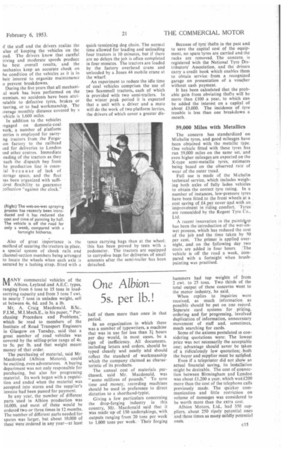One A lbion
Page 53

If you've noticed an error in this article please click here to report it so we can fix it.
5s. per lb.!
MANY commercial vehicles of the Albion, Leyland and A.E.C. types, ranging from 6 tons to 15 tons in loadcarrying capacity and from 3 tons 7 cwt. to nearly 7 tons in unladen weight, sell at between 4s. 6d. and 5s. a lb.
Mr. A. Craig Macdonald, B.Sc.. F.I.M., M.I.Mech.E., in his paper, " Purchasing PrOcedure and Problems," which he read to members of the Institute of Road Transport Engineers in Glasgow on Tuesday, said that a great number of road vehicles was covered by the selling-price range of 4s. to 5s. per lb. and that weight meant money of that order.
The purchasing of material, said Mr. Macdonald (Albion Motors), could be exciting, even adventurous. A buying department was not only responsible for purchasing, but also for progressing material. Its work began with a requisition and ended when the material was accepted into stores and the supplier's invoice had been passed for payment. In any year, the number of different parts used in Albion production was 16,000, and most of these would be ordered two or three times in 12 months. The number of different parts needed for spares was larger, but about 10.000 of these Were ordered in any year—at least half of them more than once in that period. In an organization in which there was a number of typewriters, a machine that was in use for less than 31 hours per day would, in most cases, be a sign of inefficiency. All documents, including letters and orders, should be typed cleanly and neatly and should reflect the standard of workmanship which the company claimed as characteristic of its products.
The annual cost of materials purChased, said Mr. Macdonald, was "some millions of pounds." To save time and money, tecording machines should be used in preference to direct dictation to a shorthand-typist.
Giving a few particulars concerning the drop-forging industry in this country, Mr. Macdonald said that it was made up of 150 undertakings, with outputs ranging from 20 tons per week to LOW tons' per week. Their forging hammers had tup weights of from 2 cwt. to 25 tons. Two thirds of the total output of these concerns went to the motor industry, he said.
When replies to inquiries were received, as much information as possible should be put on one record. Separate card systems for pricing. ordering and for progressing, involved duplication of information, unnecessary movement of staff and, sometimes, much searching for cards. Some of the axioms postulated in considering quotations were: The lowest price was not necessarily the acceptable one; advantage should never be taken of a ridiculously low quotation; both the buyer and supplier must be satisfied.
Even if a teleprinter did not show an actual financial saving, its installation might be desirable. The cost of connection between Birmingham and London was about £1,200 a year. which was £200 more than the cost of the telephone calls previously made. The quicker communication and little restriction on volume of messages was considered to be worth more than the extra cost.
Albion Motors, Ltd., had 350 suppliers, about 250 ripely potential ones and three times as many mildly potential ones.




























































































